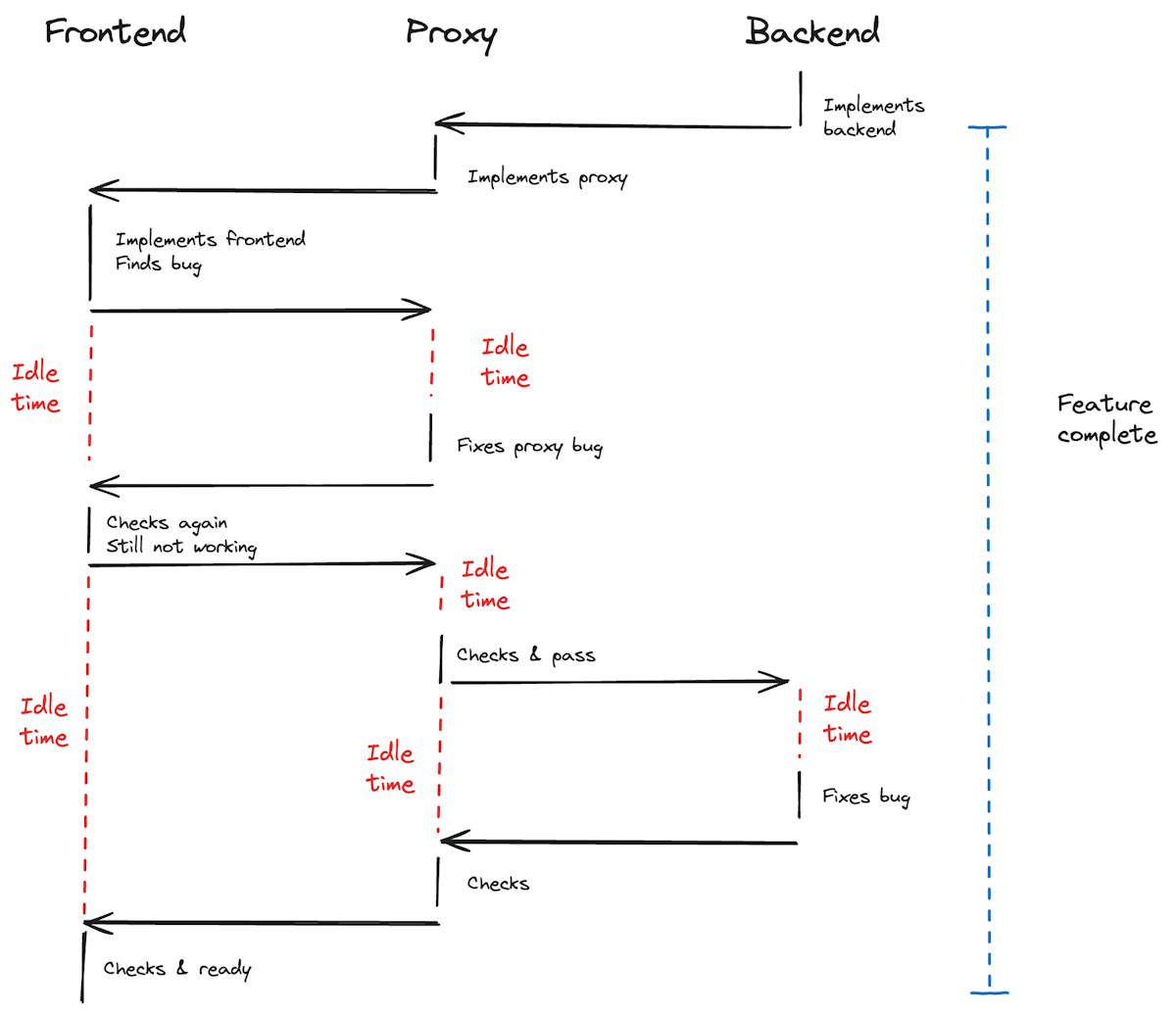
Domino Effect: The Coordination Nightmare - What Are Alternatives?


Imagine a scenario that's all too common in the world of web development—a project divided across three distinct layers: backend, proxy (gateway), and frontend. Each layer manned by a dedicated engineer. This setup, while seemingly organized, sets the stage for a coordination nightmare that can drastically slow down the development process.
The Domino Effect of Dependencies
Let me introduce 3 devs, who take care of system. Each has its own speciality.

To implement a new feature, work must progress through each of these layers in sequence. The backend team kicks things off, followed by the proxy layer, and finally, the frontend team brings it all together. Sounds straightforward, right? Unfortunately, this is where the complexities of modern web development begin to rear their head.
- The backend dev completes their part and hands it off to the proxy team.
- Once the proxy layer is implemented, it's time for the frontend team to integrate the frontend aspects.
- …
This is where the scenario starts to unravel. The frontend engineer writes the code and runs a system check, only to encounter errors. Naturally, he assumes the issue lies within the frontend code and begin troubleshooting. However, despite his best efforts, everything on the frontend checks out.
- Back to the Proxy: The frontend engineer then asks the proxy engineer to review their layer, but the proxy engineer has already moved on to another task. The frontend engineer must wait, delaying progress further.
- Discovery and Revision: Eventually, it's discovered that a flag was missing in the proxy layer. After adjustments, the frontend engineer tries again, only to face a new, different error.
- The Backend Culprit: The cycle repeats until it becomes clear that the problem originated in the backend. However, the backend engineer is now engaged with the next feature and must juggle tasks to address the bug.
Since picture is worth 1000 words. Let’s see sequence chart on how the work is “progressing”.

The Cost of Siloed Development
This iterative process of troubleshooting across teams leads to significant delays. It also breeds frustration among team members. Each layer's dependency on the previous one for troubleshooting and fixes creates a bottleneck. Thus extending the timeline for delivering a feature far beyond initial estimates.
The Critical Question
How long does it take to deliver that feature? In this worst-case scenario, the answer is far longer than it should. That’s the inefficiency build-in this siloed approach. It underscores the importance of having team members who can navigate across all layers of development—AKA the full-stack developer.
The Value of Full-Stack Developers
In contrast to the scenario described, full-stack developers possess the ability to understand and work on the backend, proxy, and frontend. This comprehensive skill set allows them to identify and address issues across the entire stack. It results in significantly reduced time spent on troubleshooting and coordinating workflow. They are the ones who can bridge the gap between front-end and back-end. Their holistic understanding of the system allows them to make informed decisions that impact the entire application lifecycle, from conception to deployment. Moving back and forth different layers don’t require handoff.
The most critical aspect is that for full-stack developer, feature is complete when it works end-to-end. Unfortunately, it’s common for developers to treat feature complete, as soon as their work is done. I’ve seen plenty cases when backend engineers stated feature is complete, only to turn out that REST API is implemented. Frontend devs are usually the last to implement their part. Thus after frontend is ready, one can say that feature is complete.
The evolving landscape of web development, with its increasing complexity, makes the full-stack developer not just a luxury but a necessity. Industry is moving faster. Applications require more features to get clients. Full-stack developers epitomize the agile and efficient workflow that startups and dynamic projects desperately need. As we move forward, full-stack role will only become more critical in delivering the innovative, robust, and secure web applications that users demand. Fortunately, with the rise of AI tools, it could be simpler than before.
There’s one big problem with full-stack developers. If you take a look at modern web project, you’ll instantly see complexity. I’m not taking about complexity in terms of business domain. I’m talking about vast number of technologies used. To understand whole picture, full-stack developer needs to be familiar with everything. Take a look at my previous post about Adapting to the Web's Complexity: The Critical Role of Full-Stack Developers in Startup Environment to see "incomplete" list of full-stack developer responsibilities. To keep up with all those technologies is challenging. To become an expert is impossible.
Alternatives to Full-Stack Development: The Role of Testing
The versatility of full-stack developers offers a compelling solution to the coordination challenges. Still it's worth exploring alternatives that can also mitigate these issues. One such alternative is testing, specifically e2e and integration tests.
The Case for Testing
Testing, particularly e2e and integration tests, presents a viable strategy for ensuring that different parts of an application work seamlessly together. Each team implements feature with predefined requirements, expressed by e2e tests. Here's how testing can improve project, while at the same time helping with mitigating domino effect:
- Detects Interactions and Dependencies: They help uncover issues in the interfaces and communication between modules, ensuring that different parts of the application work together seamlessly.
- Finds System-wide Issues: These tests validate the entire system's functionality, from start to finish, under a variety of scenarios, ensuring the software meets the overall design and operational requirements.
- Reduces Costs in the Long-Term: Early bug detection helps avoid expensive fixes post-deployment, significantly cutting down on costs associated with defect rectification.
- Increases Confidence in the Release: Comprehensive testing ensures the software's stability, boosting the development team and stakeholders' confidence in the release.
- Ensures User Requirements are Met: By testing the software from the user's perspective, it confirms that all user requirements are fulfilled, enhancing the user experience.
- Facilitates CI/CD: Regular testing is key to CI/CD practices, enabling quicker and more dependable feature rollouts and updates.
- Enhances Customer Satisfaction: By delivering a higher quality product, these testing approaches lead to improved customer satisfaction and loyalty.
Even thought, there’s a number of advantages of testing, we stil need to calculate ROI. Testing is complex beast. The number of projects without tests shows clearly that’s not easy as it sounds. Here’s few things to consider:
- Time Investment in Testing: While setting up comprehensive integration or e2e tests requires a significant time investment, the payoff can be substantial. Good tests can catch issues early, reduce the need for manual coordination, and streamline the development process.
- Dynamic Environments and Test Fragility: In a startup environment, where business requirements and application features can change rapidly, tests—especially e2e tests—can become fragile. However, this challenge must be balanced against the risk of not testing thoroughly, which can lead to more significant issues down the line.
- Customer-Driven Decisions: Ultimately, the decision on how much to invest in testing versus relying on full-stack developers may be driven by customer needs and the startup's stage. Early-stage startups might prioritize speed and agility, while more mature startups could benefit from a more structured approach to testing.
You need to do Cost-Benefit Analysis. Investing in testing, particularly in a dynamic startup environment, requires a careful cost-benefit analysis. While clean code and thorough testing practices have upfront costs, they can lead to savings in the long run by reducing bugs, rework, and the need for extensive cross-team coordination.
Contract Testing
Contract testing is a method used in software development to ensure that services (such as APIs or microservices) can communicate with each other correctly. Contract testing can serve as a middle ground, ensuring that the interfaces between different parts of the application (e.g., frontend and backend) adhere to agreed-upon contracts. These contracts define the expected requests and responses between services, ensuring that both sides of the interaction adhere to the agreed-upon format and data structure. This can reduce the back-and-forth typically required to get different parts of the application to work together.
Contract testing is common in microservices environments. It helps when individual services are developed and deployed independently.
Testing as a Strategic Tool
Implementing a robust testing strategy can serve as a critical tool in a company's development arsenal. By catching integration issues early through tests, teams can focus on delivering features more efficiently. However, it's important to recognize that testing is not a panacea. The effectiveness of this approach depends on the company's ability to invest in creating and maintaining high-quality tests and balancing this investment against the agility provided by full-stack developers.
Reality Check: The Full-Stack Developer
The allure of full-stack development as a comprehensive solution to the domino effect of coordination challenges is undeniable. The prospect of having a single developer or a team of developers capable of handling every aspect of a project—from frontend to backend, database management, and beyond—presents an appealing simplicity. However, this approach is not without its own set of significant challenges.
The Promising Solution, But …

On the surface, full-stack developers appear to be the ideal solution to the coordination nightmares and inefficiencies that plague divided development teams. Their ability to seamlessly navigate between different layers of development can ostensibly eliminate the delays caused by cross-team dependencies and miscommunications.
Despite these advantages, the reality of full-stack development is complex and fraught with challenges:
- Keeping Up-to-Date: The evolving landscape of web technologies makes it increasingly difficult for full-stack developers to stay current across all areas. The depth and breadth of knowledge required to maintain expertise in multiple domains are substantial, raising questions about the feasibility of truly mastering the full stack.
- Quality vs. Quantity: The broad scope of responsibilities can lead to compromises in quality. With the focus spread across so many areas, there's a risk of lack of knowledge in critical areas such as security, performance, and scalability.
- Finding the Right Talent: Hiring good full-stack developer is a challenge. It’s hard to find ones who are proficient in all necessary technologies and methodologies.
- One-Size-Fits-All Pitfalls: Full-stack developers may not always have the specialized knowledge required for specific challenges. There's a risk of adopting a one-size-fits-all approach to problem-solving. It may not always yield the best outcomes for complex or highly specialized requirements.
- Strategic Deployment: Determining when and how to effectively deploy full-stack developers within a project requires strategic thinking. Not all projects may benefit equally from a full-stack approach, especially as they scale and their complexity increases.
Full-stack developers can offer significant advantages in terms of agility & efficiency. At the same time, companies must also consider the limitations and challenges of this approach.
The Balanced Approach
Ultimately, a balanced approach that combines full-stack development with specialized expertise in key areas may offer the best path forward. This could involve leveraging full-stack developers for their versatility and oversight. Additionally, hiring experts for critical aspects of a project where deep expertise is non-negotiable.
Navigating the Domino Effect: A Strategic Summary
Domino effect presents significant hurdles in the development process. Strategic planning and team management can mitigate these issues. The goal is to ensure smoother project execution and delivery. Here are essential strategies to consider:
- Diverse Skill Sets: Building teams composed solely of specialists in a single area can lead to significant bottlenecks and wasted resources. A balanced team that includes both specialists and versatile developers can provide the agility needed to navigate complex projects without getting stuck at bottlenecks.
- Value of Full-Stack Developers: Despite the challenges associated with finding and nurturing full-stack developers, their value cannot be overstated. These "unicorns" bring tremendous advantages by bridging gaps between different development domains, reducing the need for cross-team coordination, and accelerating project timelines.
- Collaborative Learning: Encouraging knowledge sharing among team members can enhance the overall capabilities of the team. Even if not every developer becomes a full-stack expert, fostering an environment where developers can understand, locate bugs, and introduce simple fixes across the stack enhances team efficiency and project resilience.
- End-to-End Tests: Implementing comprehensive e2e tests might be challenging, but their value in ensuring the integrated functionality of complex systems is unparalleled. These tests can catch issues that might otherwise slip through the cracks, reducing the domino effect of coordination problems. . Combating the domino effect in web development requires a balanced approach. Leverage the strengths of both specialized and versatile developers. Incorporate robust testing strategies. That’s long term play so focus on collaboration & learning.